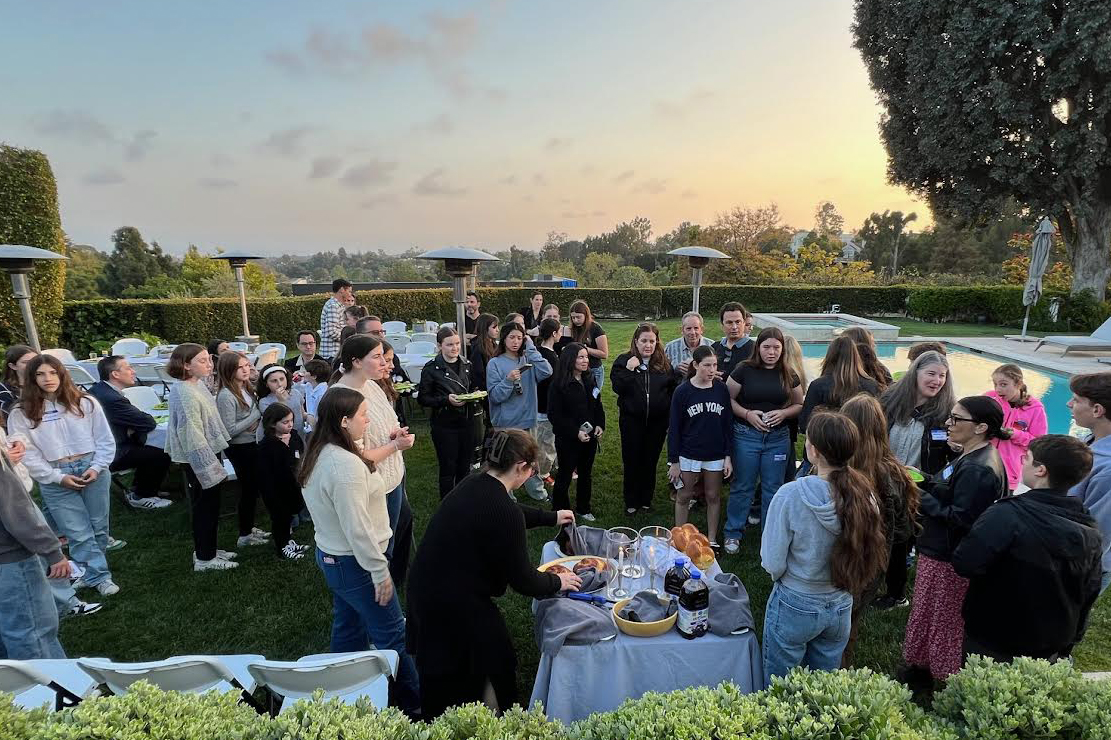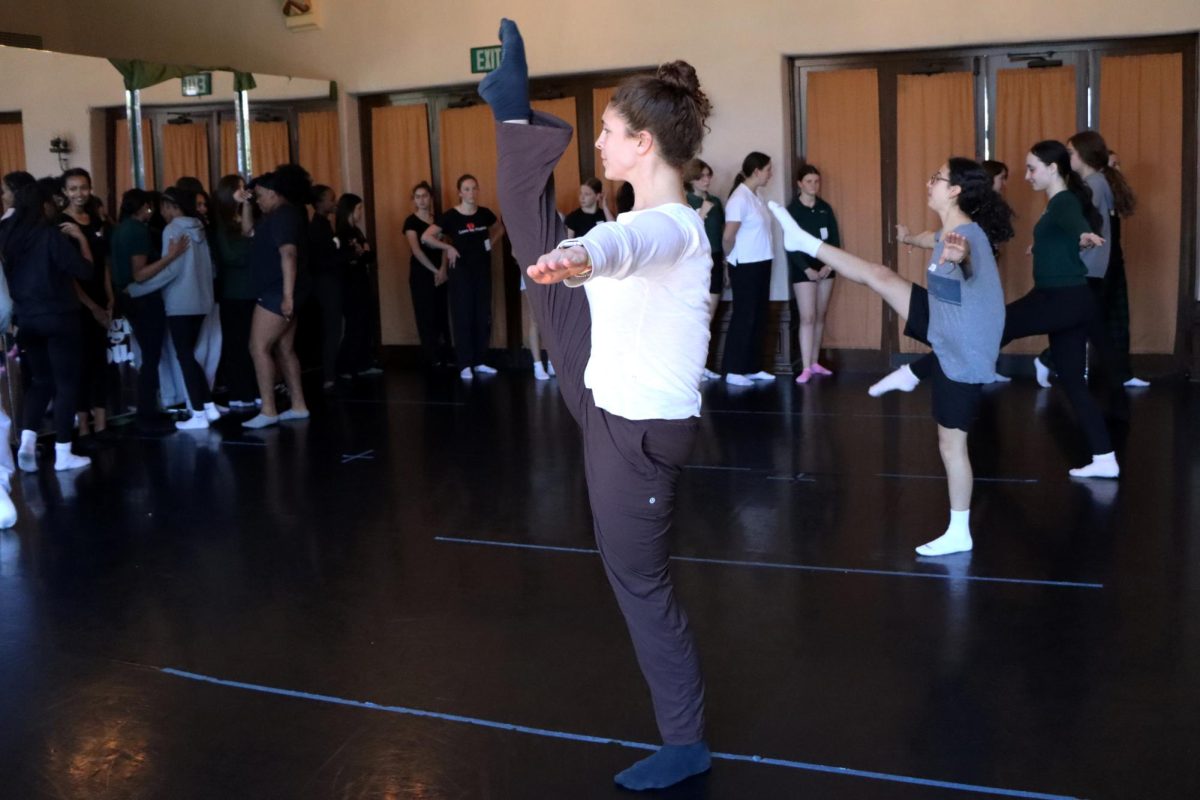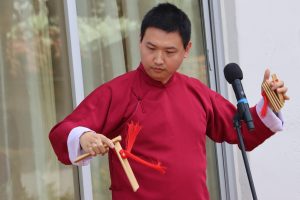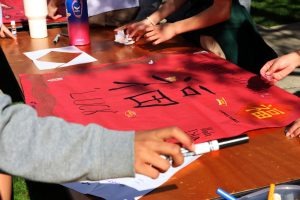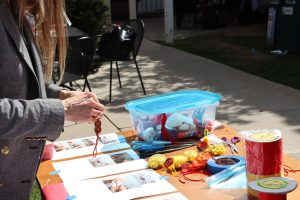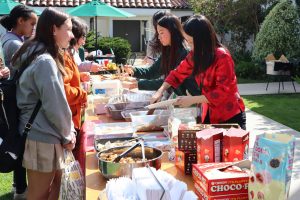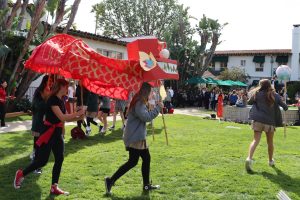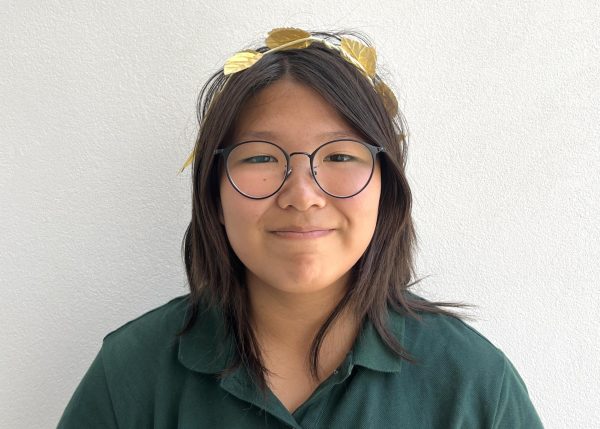Chinese teacher at Crean Lutheran High School Ran Liu perf0rms a Chinese tongue twister using a large and small kuài bǎn, or bamboo clappers. Kuài bǎn directly translates into “fast boards,” which are used for oral storytelling, and Chinese Intensive student Belén Haro (’26) performed a Chinese tongue twister with kuài bǎn during the Lunar New Year celebration. “I learned about the Lunar New Year through the 12 zodiac signs,” Haro said. “I learned more about traditional Chinese music, festivities and food; through that I was able to expand my knowledge of Chinese culture and what others do during the celebration. I’ve learned how to play the kuài bǎn, a storytelling instrument that beggars used to perform for money.”
Photo credit: Melinda Wang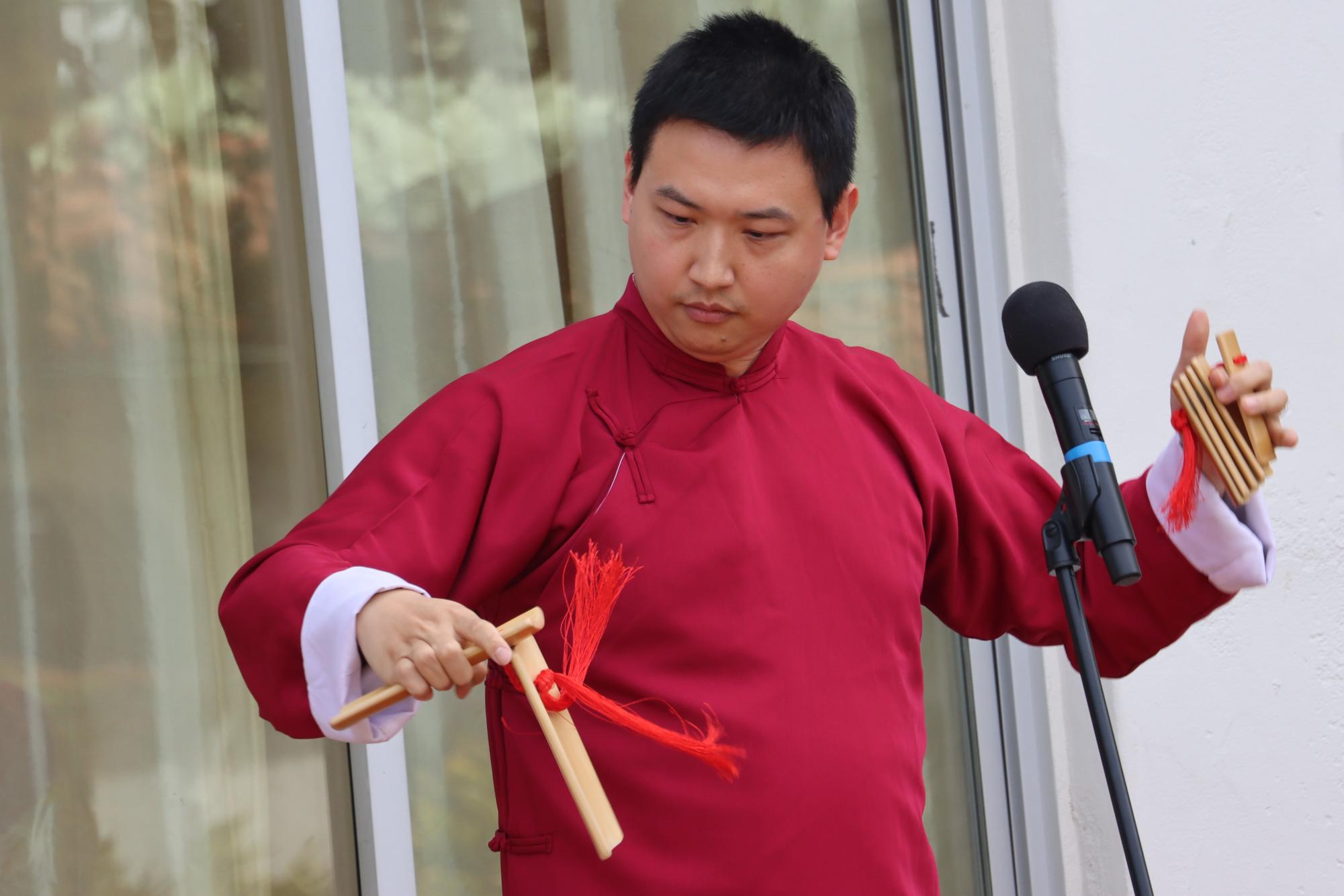
Sixth grade students make posters for their calligraphy booth. The Chinese character “福,” or fú, was traditionally written on red pieces of paper and displayed upside down on doors or windows in homes, as the description of the upside down character is fú dào le, which translates to “luck has come.” “[Students] don’t have time to get deeply involved with Chinese language, but it’s New Year’s, so we learn about Lunar New Year celebrations, traditions and food,” world language teacher Susan Chen said. “[Students] did calligraphy the other day, so it’s good for them to apply what they learned into something like showing the entire school how to do it.”
Photo credit: Melinda Wang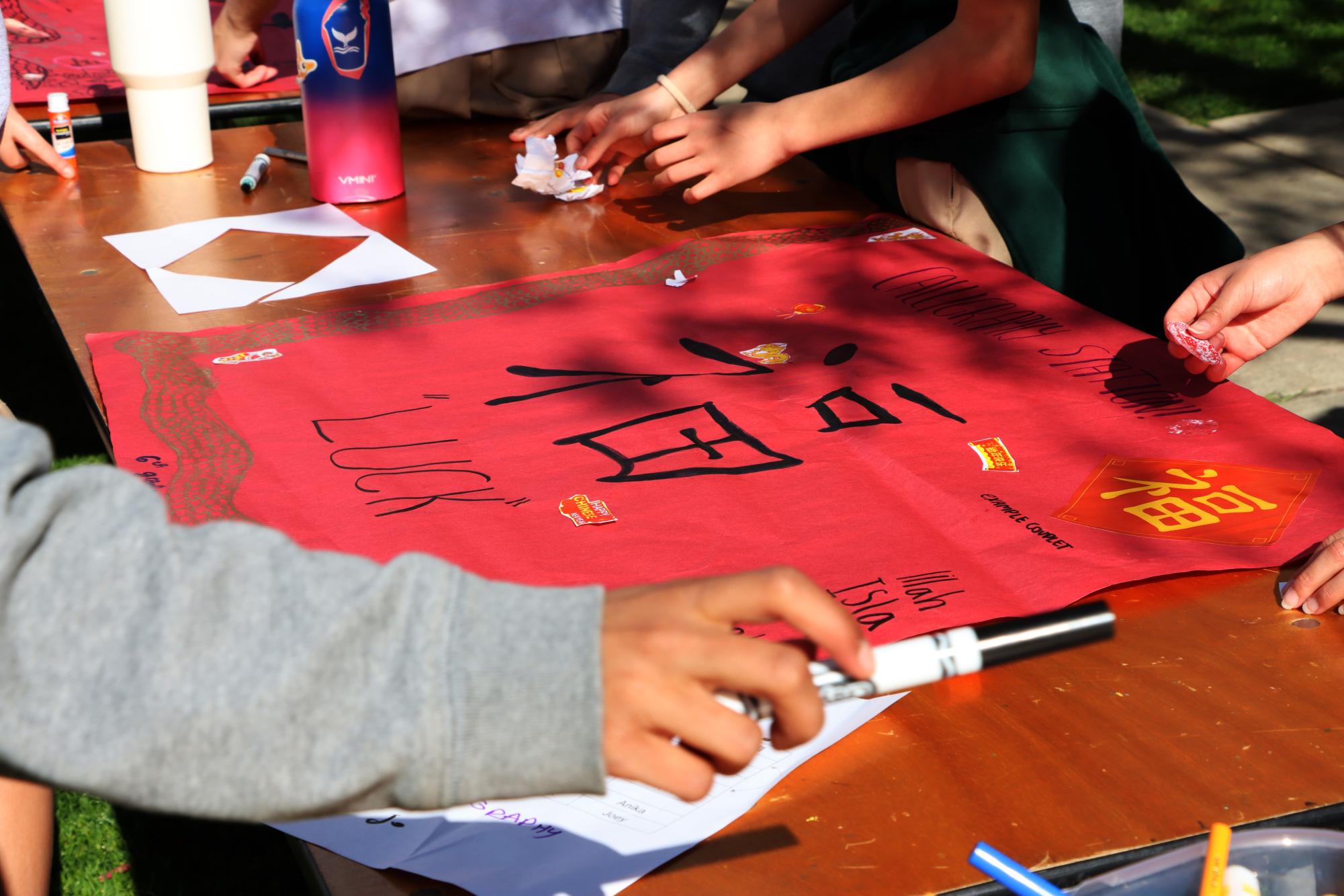
Sixth graders taking the Chinese rotation course Ava Waddell, Izzy Gladstone, Margaret Youssef and Jemima Brooks hold up a red poster depicting a hand-drawn dragon. The students spent the past few weeks learning about Lunar New Year traditions and myths, which included the story of a ferocious monster called the Nian. “We learned about the food people eat and traditions,” Brooks said. “We learned how to write calligraphy on the little red poster and how red keeps off the [Nian].”
Photo credit: Melinda Wang
Seventh graders Sacha Yick and Yuri Song stand in front of a booth showcasing wooden fans with Chinese phrases laser-cut into them. Students in Chinese 1 and 1B classes used Adobe Illustrator to design their fans and used the laser-cutter in the IDEAlab to physically create their designs and phrases, including xīn nián kuài lè, which means, “Happy New Year” and gōng xǐ fā cái, which means, “May you be happy and prosperous.” “Each fan has a different wish on it. I did lóng nián kuài lè, which means, ‘Happy Year of the Dragon,'” Song said.
Photo credit: Melinda Wang
English teacher Kathleen Keelty makes a Chinese keychain with fēng shuǐ coins, which represent wealth and abundance and are often hung on doors with red string or under the bed to attract wealth in one’s home. Chinese Advanced Study student Kayla Bruce (’24) oversaw the booth and assisted students and faculty in creating their own keychains. “Chinese keychains are supposed to symbolize good luck and prosperity for the new year. If you can eyeball four inches [of red string], then it’s especially good luck,” Bruce said. “It’s fun to do this booth because I get to interact with other grades I don’t normally get to see. I love seeing the fashion show too, and seeing my friends and my peers makes me so proud. Everyone looks so beautiful, and I like preparing for this festival in class.”
Photo credit: Melinda Wang
Three Beijing opera masks are displayed on a table. Traditionally, performers wore these masks while they sang and dressed up to match the scenario they performed. Each of the masks’ colors represent a different trait. “The red ones represent royalty. The yellow ones represent peers. The green ones represent toughness and chivalry. The blue ones represent strength. The purple ones represent filial piety. The white ones represent treachery, the black ones represent justice. Any metallic gold or silver ones represent the gods, buddhas and ghosts,” Katia Thomas (’27) said. “We picked a color or design that we wanted to draw and we made our own. We tried to make a diverse range of colors so we could represent them.”
Photo credit: Melinda Wang
World language teacher Pei-Ying Gosselin and Asian Pacific-Islander Student Union Executive Board member Sophia Shin (’25) serve Asian food to students. From scallion pancakes to japchae, APSU members shared food and snacks from a variety of Asian cultures with Archer students and faculty. “We live in America, so it’s nice to see a lot of people embracing [Asian] culture and really leaning into it,” APSU Executive Board member Natalie Huang (’25) said.
Photo credit: Melinda Wang
Bernice Wong (’27), Snow Zhou (’27) and Lauren Ho (’26) help run the tea booth while Chinese Intermediate students help out at other booths. Students and faculty could choose to sample green, black, white or oolong tea.”I don’t know if it’s my favorite [tradition], but I did enjoy learning a lot about tea,” Chinese Intermediate student Eden Sinclair (’25) said. “We spent a lot of time learning about the different teas and how to prepare them.”
Photo credit: Melinda Wang
Chinese students perform the dragon dance. While Gosselin said she attempts to implement different Lunar New Year traditions and activities for the annual celebration, she said she never switches out the dragon dance or calligraphy station. Gosselin added that many activities are included or removed based on the curriculum, and it is important for students to celebrate diverse holidays. “It’s very important [to celebrate] holidays from different countries, different regions of the world if we have students from those countries or places,” Gosselin said. “We should all have some kind of recognition for them so they feel proud about their culture. We want our Archer community to learn about Chinese culture to appreciate cultures that differ from their own.”
Photo credit: Melinda Wang
While Lunar New Year is widely celebrated on the day of the new moon at beginning of the lunar calendar year, the holiday spans 15 days. On the 15th day of the holiday, celebrants attend Lantern Festivals to honor deceased ancestors and promote forgiveness and reconciliation for the new year. Lunar New Year is typically celebrated in East and Southeast Asian cultures. This year’s Lunar New Year fell on Feb. 10, and it is the Year of the Dragon, according to the Chinese zodiac.
Archer’s Lunar New Year celebration took place Feb. 23 during lunch, and students from Chinese 1A, 1B, 2, 3, 4 and advanced study organized booths in the courtyard that showcased calligraphy, made shaved ice and served Asian food for community members to try.

